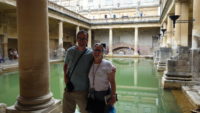 We stuck with water-feature towns today as we left Wells and came to Bath. Bath has England’s only hot water thermal spring, where rainwater in the nearby hills takes thousands of years to seep down into the earth, where it gets heated up, and the hot water, which is now under pressure, finds a fault here in Bath and comes up to the surface here in three very close-to-each-other springs. The water varies from spring to spring, but sounds as if it ranges from about 120 degrees to about 145 degrees.
We stuck with water-feature towns today as we left Wells and came to Bath. Bath has England’s only hot water thermal spring, where rainwater in the nearby hills takes thousands of years to seep down into the earth, where it gets heated up, and the hot water, which is now under pressure, finds a fault here in Bath and comes up to the surface here in three very close-to-each-other springs. The water varies from spring to spring, but sounds as if it ranges from about 120 degrees to about 145 degrees.
 Mer had gotten us 10:00 tickets to the Roman baths here. Rome invaded and settled this area around 40 AD, and the Romans were very impressed at finding this hot spring. They set up a Roman bath, one of the largest outside of Rome, and built a temple to the goddess Minerva, whom the Romans merged with the local Celtic goddess of the spring, Sulis, to make Sulis Minerva. Eventually the bath complex became huge, with the spring, the bath, several smaller pools, several saunas and cold pools, exercise areas, changing rooms, and other rooms that could have been used for massage. Then, around 400 AD, Rome had some Goth trouble, and the Roman settlement was abandoned, and the baths were forgotten and lost until the 1700s. The great bath itself wasn’t found until the 1800s when water started seeping into the basements of the houses built over it.
Mer had gotten us 10:00 tickets to the Roman baths here. Rome invaded and settled this area around 40 AD, and the Romans were very impressed at finding this hot spring. They set up a Roman bath, one of the largest outside of Rome, and built a temple to the goddess Minerva, whom the Romans merged with the local Celtic goddess of the spring, Sulis, to make Sulis Minerva. Eventually the bath complex became huge, with the spring, the bath, several smaller pools, several saunas and cold pools, exercise areas, changing rooms, and other rooms that could have been used for massage. Then, around 400 AD, Rome had some Goth trouble, and the Roman settlement was abandoned, and the baths were forgotten and lost until the 1700s. The great bath itself wasn’t found until the 1800s when water started seeping into the basements of the houses built over it.
Anyway, the Roman bath was returned to as close as we can get it to original shape. The Victorians added a terrace overlooking the bath and added statues of Roman emperors and generals. But the bath itself is original, and much of the floor around it is original. Some of the larger complex has been excavated, and the museum does an excellent job of presenting the finds. Foundations are where they were found, and other bits have been remounted on the walls of the museum in the best-guess position of where they should be, and the missing parts are drawn in or, more commonly, projected in by a computer projector so that the extra filled-in stuff can cycle on and off.
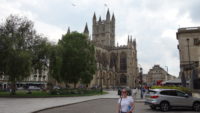 There are several multimedia film clips showing actors playing people who actually existed, which is known through dedications of altars or on tombstones. You can follow the people around and see them interact with each other. One of them paid a scribe to write out a curse on a sheet of lead so he could get the goddess to get revenge on a thief. It seems it was the practice to write out a curse on lead sheets, fold it up, and throw it into the spring for the goddess to read. The museum said that these curses are our main source for seeing the way that common Latin was used by ordinary people.
There are several multimedia film clips showing actors playing people who actually existed, which is known through dedications of altars or on tombstones. You can follow the people around and see them interact with each other. One of them paid a scribe to write out a curse on a sheet of lead so he could get the goddess to get revenge on a thief. It seems it was the practice to write out a curse on lead sheets, fold it up, and throw it into the spring for the goddess to read. The museum said that these curses are our main source for seeing the way that common Latin was used by ordinary people.
The two major finds in the museum are the head of a “gorgon” and Minerva’s head. The gorgon is a male face that is intact, and was probably the central figure of the decorations on top of the facade of the temple. One possibility is that it is actually Neptune, and therefore the snakes in his hair are actually sea serpents. The head is mounted with other fragments of the facade, and a projector fills in the missing bits as well as adding possible colors.
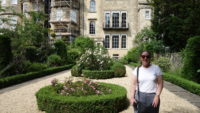 Minerva’s head would have been from her statue in the temple. In what can only be described as a good day at work, a man unearthed the head while digging a sewer line back in the late 1800s. The gilded bronze head is in excellent condition.
Minerva’s head would have been from her statue in the temple. In what can only be described as a good day at work, a man unearthed the head while digging a sewer line back in the late 1800s. The gilded bronze head is in excellent condition.
Touring the baths took us a little over two hours, which took us to lunch. After lunch, we made our way down to the train station, only to be greeted by a sign proclaiming a train strike. Mer had wanted to go to Bristol, but we decided we didn’t want to risk possibly getting stuck in a city away from our hotel and car. So, Mer came up with a quick plan B – we walked back to the square where the baths are and the cathedral is, and there we picked up a 2:30 guided tour of the city.
 It was just the guide and eight of us in all, so a nice-sized group. We started by the cathedral and baths, and she covered much about the baths we had already learned. The cathedral is one of the latest and last of the Gothic cathedrals, getting started in the late 1400s. The good part of that was that the builders knew how to maximize windows, so the glass in the church is huge and impressive. The bad part was that the church wasn’t finished by the time Henry VIII came along, so the formerly Catholic church wasn’t finished, and it sat slowly decaying for about one hundred years. Then, Elizabeth I came to town and saw that the cathedral was in poor shape, so she made the local officials organize a lottery to help pay for finishing the building. It turned out well, at least from the outside.
It was just the guide and eight of us in all, so a nice-sized group. We started by the cathedral and baths, and she covered much about the baths we had already learned. The cathedral is one of the latest and last of the Gothic cathedrals, getting started in the late 1400s. The good part of that was that the builders knew how to maximize windows, so the glass in the church is huge and impressive. The bad part was that the church wasn’t finished by the time Henry VIII came along, so the formerly Catholic church wasn’t finished, and it sat slowly decaying for about one hundred years. Then, Elizabeth I came to town and saw that the cathedral was in poor shape, so she made the local officials organize a lottery to help pay for finishing the building. It turned out well, at least from the outside.
We proceeded to go see the locations of the other two springs; spas are located there, and both are swanky and expensive. We walked up to Queen’s Square to see one of the first buildings to have a beautiful block-long unified facade. It was actually many homes behind the facade, but it looked like a single palace. It seems this is a common thing in Bath – much of the town was rebuilt in the 1700s using similar Georgian architecture, and the fronts were always beautiful. The backs could be a jumble.
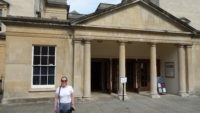 We kept going up the hill, with a quick swing into a restored 1700s garden to see what that would have looked like. We got up to the top to the Royal Crescent, which is a long, sweeping building facade that features in almost every Jane Austen film. In fact, there were lots of people setting things up to shoot for something tomorrow; the crew is tight-lipped about what they’re filming. It seems as if the residents of the Royal Crescent cooperate with films because the films pay them for the use and it helps to defray the cost of maintaining the building and grounds.
We kept going up the hill, with a quick swing into a restored 1700s garden to see what that would have looked like. We got up to the top to the Royal Crescent, which is a long, sweeping building facade that features in almost every Jane Austen film. In fact, there were lots of people setting things up to shoot for something tomorrow; the crew is tight-lipped about what they’re filming. It seems as if the residents of the Royal Crescent cooperate with films because the films pay them for the use and it helps to defray the cost of maintaining the building and grounds.
We proceeded back toward the main part of town, stopping at the Circus, a group of homes that form a circle with the same Georgian facade. Mer and I both agreed we liked the Crescent better, but these were nice homes, and perhaps slightly more affordable – especially since the last Crescent home that came up for sale went for 5.75 million pounds (7 million dollars).
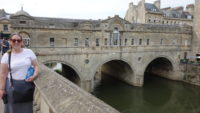 After a brief swing by the Assembly Rooms, where balls were held, we finished the ninety-minute tour down by the very cool Pulteney Bridge, which is a bridge over the river that has shops all along it. From the topside, it looks like a street – you can’t tell that the bridge is there at all apart from the shops all being very shallow. The bridge leads to a uniformly house-lined street and ends in a mansion that stands at the front of a large public garden. The river was very pretty here as well, so it made for a good ending.
After a brief swing by the Assembly Rooms, where balls were held, we finished the ninety-minute tour down by the very cool Pulteney Bridge, which is a bridge over the river that has shops all along it. From the topside, it looks like a street – you can’t tell that the bridge is there at all apart from the shops all being very shallow. The bridge leads to a uniformly house-lined street and ends in a mansion that stands at the front of a large public garden. The river was very pretty here as well, so it made for a good ending.
We checked into our hotel finally, and then went back to the bridge. Our guide had recommended walking down the street to the park, so we did that. It was a pleasant place to walk, but we did turn back a little into the park to go get supper back near the hotel.
That wrapped up our Bath exploration for the day. After multiple days of busy touring, it was good to get a fairly early evening back in the room. Since tomorrow is my day, and I had planned for a mellow-wandering kind of day, I think we’ll sleep in. Which is what we should do in a spa town.
Dropping curses to a goddess? And you wonder why I love teaching Latin.
Did you not take the waters anywhere?!?!?
There was a free place to drink at the end of the baths. Mer took the waters, but I was SURE we were going to go to the Pump Room and I was holding out for there. Turns out the Pump Room is now a SWANKY restaurant and you can’t just go in. So, I’m still as sick as ever.